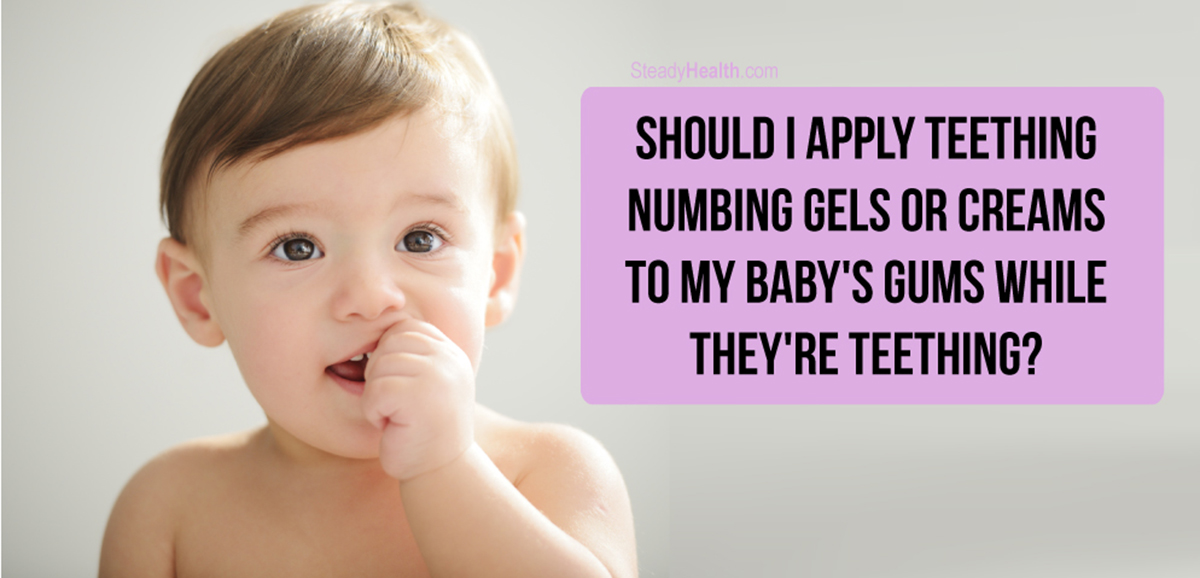For ages, teething has been considered an unpleasant experience for children and carers, and gums were treated with obscure „remedies“ such as wine or whiskey. Many parents still believe that teething symptoms should be treated with a prescription, as well as over-the-counter (OTC) medications. Even if some of the modern-day therapies for teething pain did work shortly, the risks associated with their active ingredients may outweigh the potential benefits. Besides, these products are quickly washed away by saliva, so they'd provide relief for a couple of minutes at best.

As an active ingredient, teething gels and creams have either Benzocaine, lidocaine viscous, or — if you purchase one of the homeopathic preparations — they may lack the numbing agent — but come with a dangerous belladonna poison. [1]
Teething products containing Benzocaine
Benzocaine is a prototypical over-the-counter anesthetic used in teething remedies. Despite having a long history of safe use, the anesthetic has been linked with rare cases of methemoglobinemia, a condition where the oxygen-carrying capacity of the blood is greatly reduced.
Although most of the reported methemoglobinemia cases involve Benzocaine spray application in a hospital environment, OTC use of Benzocaine has been linked with the disease as well. Symptoms of methemoglobinemia include pale blue-grayish lips, skin and fingernails, headaches, difficulties breathing, lightheadedness, and increased heart rate, among others.
Once a child is older than two years, Benzocaine-based numbing agents are considered safer to use, but they're never considered completely safe, not even for adult use. [2, 3]
Benzocaine is present in well-known teething products such as Anbesol, Orajel, Baby Orajel, Orabase, and Hurricane, and here you can read more about the dangers of teething gels or medications with benzocaine.
Lidocaine (lignocaine) teething gels and creams
Lidocaine viscous works against teething pain, it's a fact, at least until it's washed away by saliva! [5]
The two-percent solution of lidocaine gel — when compared to a placebo gel with the same composition without lidocaine — showed successful in the treatment of several kinds of pain originating in the oral cavity such as gingivitis, ulcers, blisters, cold sores, hand-foot-mouth disease, as well as teething discomfort in younger children.
Numbing gels containing salicylate salts
Experts including UK’s Medicines and Healthcare products Regulatory Agency (MHRA) and New Zealand’s Medicines and Medical Devices Safety Authority have advised parents to avoid using teething remedies containing choline salicylate because there's a theoretical chance that they may cause a serious illness called Reye’s syndrome. Even though there weren't any known cases of the disease, children were admitted to hospital on many occasions. [7]
Some of the well-known topical products containing choline salicylate include Bonjela Teething Gel, and Ora-sed gel. The most common symptoms of numbing gel-related poisonings include tremor, gastrointestinal problems, hyperventilation, and the risk of death.
Homeopathic teething gels and creams
Even though homeopathic preparations don't contain common numbing agents, and are said to be „all-natural“, they're considered unsafe because the packages contain inconsistent amounts of belladonna — a poisonous plant that can inhibit the nervous system — cause blurred vision, red and dry skin, fever, hallucinations, inability to urinate or sweat, mental problems, seizures, coma, and even death. Here you can read more about homeopathic teething tablets and gels for baby teething, and how safe they are for our children.
Is there a safe teething remedy for my baby?
Dr. Janet Woodcock from the FDA's Center for Drug Evaluation and Research, in their advisory against these products, states that you don't need over-the-counter nor prescription medications to treat teething pain in children because teething is a natural process all children have gone through since time immemorial. [8]
Instead of using numbing gels or creams, and painkillers, the American Academy of Pediatrics advises parents and caregivers to treat teething pain as naturally as possible. They recommend using a teething ring made of firm rubber — cold but never frozen — and a gentle massage of baby's gums with a clean finger to relieve the teething pain. [9, 10, 11] It's always good to know about the best and worst teething toys you can offer to your teething baby.
These were some facts about numbing gels and creams for relieving teething pain in children. Nobody will tell you what to do with your own child and whether you should apply numbing gels or creams on her gums. You have all the right to make decisions for her, as long as you don't endanger her life. Some of the teething remedies are proven dangerous and it's always a good idea to do your own research and/or consult your family doctor or a pediatrician before trying them on a baby.
- Photo courtesy of SteadyHealth.com


Your thoughts on this